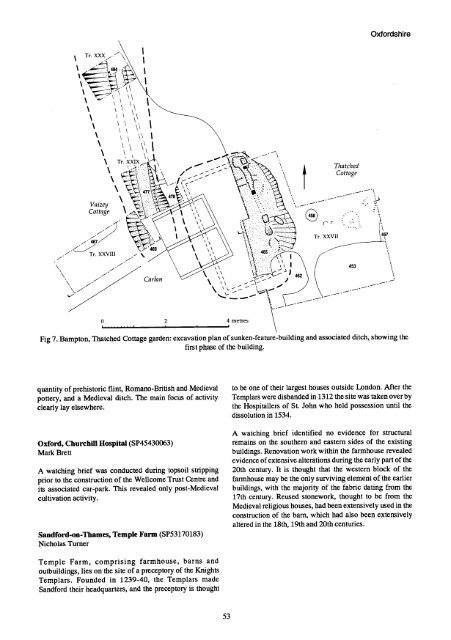CBA SMA\SMA 1998.PDF - Council for British Archaeology
CBA SMA\SMA 1998.PDF - Council for British Archaeology
CBA SMA\SMA 1998.PDF - Council for British Archaeology
Create successful ePaper yourself
Turn your PDF publications into a flip-book with our unique Google optimized e-Paper software.
Ox<strong>for</strong>dshire<br />
Tr. XXX<br />
1 .<br />
(<br />
Thatched<br />
Cottage<br />
Vaizey<br />
Cottage<br />
N.. --<br />
---<br />
467<br />
7.7. XXVIII<br />
Carlan<br />
\ \<br />
\<br />
\<br />
\<br />
\<br />
\<br />
462<br />
Tr. XXVII<br />
453<br />
457<br />
0 2 4 metres<br />
Fig 7. Bampton, Thatched Cottage garden: excavation plan of sunken-feature-building and associated ditch, showing the<br />
first phase of the building.<br />
quantity of prehistoric flint, Romano-<strong>British</strong> and Medieval<br />
pottery, and a Medieval ditch. The main focus of activity<br />
clearly lay elsewhere.<br />
Ox<strong>for</strong>d, Churchill Hospital (SP45430063)<br />
Mark Brett<br />
A watching brief was conducted during topsoil stripping<br />
prior to the construction of the Wellcome Trust Centre and<br />
its associated car-park. This revealed only post-Medieval<br />
cultivation activity.<br />
Sand<strong>for</strong>d-on-Thames, Temple Farm (SP53170183)<br />
Nicholas Turner<br />
to be one of their largest houses outside London. After the<br />
Templars were disbanded in 1312 the site was taken over by<br />
the Hospitallers of St. John who held possession until the<br />
dissolution in 1534.<br />
A watching brief identified no evidence <strong>for</strong> structural<br />
remains on the southern and eastern sides of the existing<br />
buildings. Renovation work within the farmhouse revealed<br />
evidence of extensive alterations during the early part of the<br />
20th century. It is thought that the western block of the<br />
farmhouse may be the only surviving element of the earlier<br />
buildings, with the majority of the fabric dating from the<br />
17th century. Reused stonework, thought to be from the<br />
Medieval religious houses, had been extensively used in the<br />
construction of the barn, which had also been extensively<br />
altered in the 18th, 19th and 20th centuries.<br />
Temple Farm, comprising farmhouse, barns and<br />
outbuildings, lies on the site of a preceptory of the Knights<br />
Templars. Founded in 1239-40, the Templars made<br />
Sand<strong>for</strong>d their headquarters, and the preceptory is thought<br />
53

















